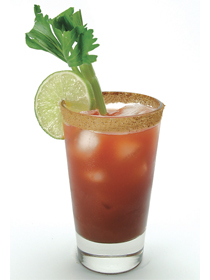Vodka 101
Posted on July 25th, 2017 by Cannata'sVodka is a chameleon and blends seamlessly with just about anything. This is no accident: While there are no universal rules for producing the spirit, the final product is supposed to be colorless, odorless and tasteless. With that said, vodka isn’t completely neutral, and a number of distillers actually leave in a good amount of flavor. (The best way to taste these subtle differences is to drink vodka neat at room temperature.)
Traditionally, vodka was made from potatoes, corn or grains, but it is now made from a range of exotic bases including grapes, maple syrup and even soybeans. Unlike Scotches and cognacs, which are made in pot stills, vodka is usually produced in a high-volume, continuous column still. After distillation, the spirit is filtered to remove any remaining impurities. Coal is a traditional filter, but brands today use a range of materials, even including diamonds. Vodka isn’t aged and can be bottled and sold immediately after production. What’s also helping to drive sales in America is the wide range of flavored vodkas now on the market.

A COLUMN STILL used to distill vodka.
While the spirit may be clear, its history isn’t. No one is sure where it was first made. Each vodka-producing country, of course, claims to be the inventor. What we do know is that people began drinking vodka in America as early as the beginning of the 20th century. Sales of the spirit were low until after World War II, when Americans began to shift away from Scotch and bourbon. This movement was helped by Smirnoff’s aggressive marketing in the ‘50s and ‘60s and later by the introduction of the Swedish Absolut and the super-premium Grey Goose. Today, vodka is the most popular spirit in America and outsells rum, tequila and gin combined.
Vodka is less delicate than gin, so you can vigorously shake it over ice. I like to shake it very well so that it’s super cold. You definitely can’t do that with straight gin since the flavor is so delicate and it bruises.
Flavored Vodkas
Flavored vodkas are the new “thing” in mixology. Some simulate the taste of a variety of desserts and candies. More obscure flavors like salmon, bacon, hemp, and even tobacco, though these tend to not last long on the market. Some flavored vodkas are produced using the traditional infusion method of steeping ingredients like fresh fruits and herbs in a finished vodka. Some use flavor extracts, which typically creates a lower quality vodka.
Another option for flavored vodkas is to do your own infusion. Beginning with a clear vodka and using fresh fruits, herbs, and spices, you can easily create your own flavor combinations that are fun to use in a variety of cocktails.
The Bloody Caesar
Since its conception in 1969, the sodium-ridden, tomato-based Calgary cocktail has soared to the top of the boozy charts in Canada, becoming one of this country’s most notable drinks. No one’s really sure why the beverage’s popularity grew so rapidly, but it’s estimated that more than 350 million Caesars are consumed by Canadians every year. That’s approximately ten Caesars per person, per year—and if you took a poll in Calgary, that number would be significantly higher.
The man who poured this cocktail into existence, Walter Chell, was the bar manager of what is now The Westin hotel in downtown Calgary, and drew inspiration from a classic Italian pasta dish made of tomato sauce and clams. The basic formula for a Caesar is pretty straightforward: Clamato (sourced from various American cities like Seattle, Washington or Whitefish, Montana), Worcestershire, Tabasco, a variety of spices—typically salt, celery salt, and black pepper—and vodka. (The inclusion of clam juice is crucial, as it adds a robust, umami flavor that offers a lot more depth than its American cousin—the Bloody Mary.) And most importantly: some very serious garnishes.
It doesn’t take a rocket scientist to make one at home, but Canadian bartenders have created variations on the classic continuously over the decades, putting spins on it by opting for a variety of ingredients like cucumber-infused gins, muddled herbs like basil or rosemary, and sometimes even fruit juices. The uninspired may finish off the cocktail by shoving a celery stalk in there, but any self-respecting Caesar lover knows that the garnish on this drink is just as—if not more—important than what you’re sipping on. The decorations alone make this the Liberace of all Canadian cocktails. In some establishments, you can even eat an entire meal on top of your cocktail. Pickles, beans, and olives are pretty standard, but if you’re lucky enough to find a pepperoni stick, bacon, a big chunk of smoked salmon, or even some fried chicken atop your tomato-y bevvy, then you’re drinking this beverage as Walter Chell would have wanted you to.

The Bloody Caesar
- 4 shots Sriracha vodka
- 3 shots Cucumber vodka
- 3 dashes black pepper
- 3 dashes celery salt
- 4 drops Worcester sauce
- 4 shots Tabasco
- 1/2 oz. dry Italian Dressing mix (optional for more zest)
Method: Mix vodkas, black pepper, celery salt, Worcester Sauce, Tobacco and dry Italian dressing mix in a cocktail shaker. Add ice and shake. Pour mixture with the ice into large glass rimmed with celery salt and fill with Clamato juice.
Garnish ideas: Grilled shrimp, chees cubes, hot peppers, BBQ Sausage, pepperoni, dill pickles, celery stalks, cucumber, cherry tomato, lime, spicy green beans.
Liqour | July 25th, 2017


